Financial Reporting Analysis: Bell Financial Group Impairment Testing
VerifiedAdded on 2020/05/28
|9
|2649
|73
Report
AI Summary
This report provides a detailed analysis of Bell Financial Group's impairment testing process, focusing on the financial year ending 2016. The analysis examines the company's approach to testing various assets, including intangible assets (goodwill, research and development, customer lists), loans and advances, property, plant, and equipment, and trade receivables, in accordance with AASB 136. The report highlights the key assumptions and estimates used by the company, such as the annual testing of assets, ongoing impairment checks for trade receivables and loans, and the use of a 11% after-tax discounting rate. The analysis also critiques the subjectivity involved in the impairment testing, particularly the zero impairment charges reported across all asset categories, and the lack of detailed calculations. Furthermore, the report discusses the implications of the former accounting standard on lease liabilities and its impact on financial reporting, particularly the off-balance sheet liabilities associated with operating leases and the need for the new accounting treatment. It highlights the challenges and benefits of changes in lease accounting treatment and the need for comparability in financial reporting. The report concludes by discussing the changes in lease accounting treatment and the need to reflect the real accounting picture of the business.
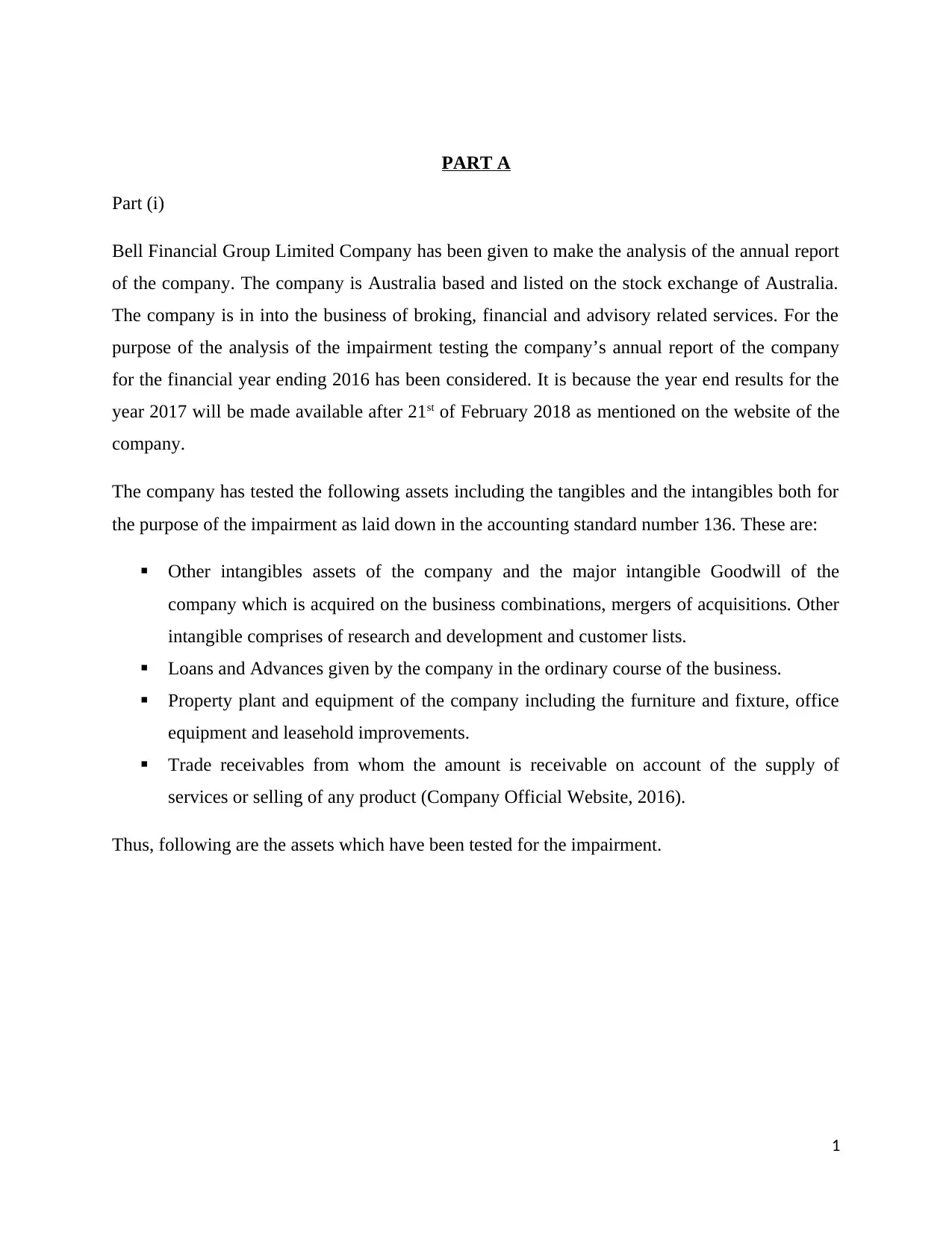
PART A
Part (i)
Bell Financial Group Limited Company has been given to make the analysis of the annual report
of the company. The company is Australia based and listed on the stock exchange of Australia.
The company is in into the business of broking, financial and advisory related services. For the
purpose of the analysis of the impairment testing the company’s annual report of the company
for the financial year ending 2016 has been considered. It is because the year end results for the
year 2017 will be made available after 21st of February 2018 as mentioned on the website of the
company.
The company has tested the following assets including the tangibles and the intangibles both for
the purpose of the impairment as laid down in the accounting standard number 136. These are:
Other intangibles assets of the company and the major intangible Goodwill of the
company which is acquired on the business combinations, mergers of acquisitions. Other
intangible comprises of research and development and customer lists.
Loans and Advances given by the company in the ordinary course of the business.
Property plant and equipment of the company including the furniture and fixture, office
equipment and leasehold improvements.
Trade receivables from whom the amount is receivable on account of the supply of
services or selling of any product (Company Official Website, 2016).
Thus, following are the assets which have been tested for the impairment.
1
Part (i)
Bell Financial Group Limited Company has been given to make the analysis of the annual report
of the company. The company is Australia based and listed on the stock exchange of Australia.
The company is in into the business of broking, financial and advisory related services. For the
purpose of the analysis of the impairment testing the company’s annual report of the company
for the financial year ending 2016 has been considered. It is because the year end results for the
year 2017 will be made available after 21st of February 2018 as mentioned on the website of the
company.
The company has tested the following assets including the tangibles and the intangibles both for
the purpose of the impairment as laid down in the accounting standard number 136. These are:
Other intangibles assets of the company and the major intangible Goodwill of the
company which is acquired on the business combinations, mergers of acquisitions. Other
intangible comprises of research and development and customer lists.
Loans and Advances given by the company in the ordinary course of the business.
Property plant and equipment of the company including the furniture and fixture, office
equipment and leasehold improvements.
Trade receivables from whom the amount is receivable on account of the supply of
services or selling of any product (Company Official Website, 2016).
Thus, following are the assets which have been tested for the impairment.
1
Paraphrase This Document
Need a fresh take? Get an instant paraphrase of this document with our AI Paraphraser
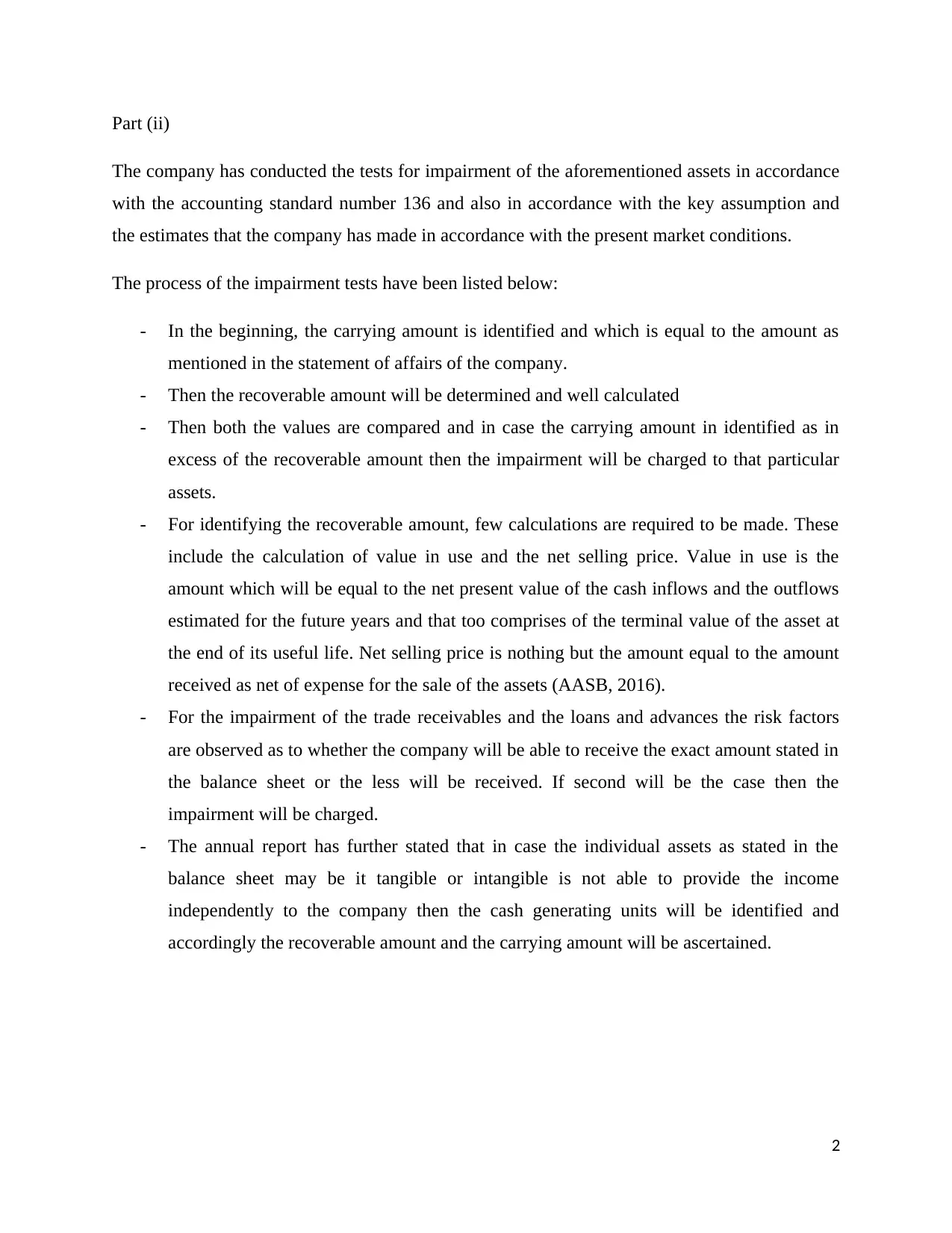
Part (ii)
The company has conducted the tests for impairment of the aforementioned assets in accordance
with the accounting standard number 136 and also in accordance with the key assumption and
the estimates that the company has made in accordance with the present market conditions.
The process of the impairment tests have been listed below:
- In the beginning, the carrying amount is identified and which is equal to the amount as
mentioned in the statement of affairs of the company.
- Then the recoverable amount will be determined and well calculated
- Then both the values are compared and in case the carrying amount in identified as in
excess of the recoverable amount then the impairment will be charged to that particular
assets.
- For identifying the recoverable amount, few calculations are required to be made. These
include the calculation of value in use and the net selling price. Value in use is the
amount which will be equal to the net present value of the cash inflows and the outflows
estimated for the future years and that too comprises of the terminal value of the asset at
the end of its useful life. Net selling price is nothing but the amount equal to the amount
received as net of expense for the sale of the assets (AASB, 2016).
- For the impairment of the trade receivables and the loans and advances the risk factors
are observed as to whether the company will be able to receive the exact amount stated in
the balance sheet or the less will be received. If second will be the case then the
impairment will be charged.
- The annual report has further stated that in case the individual assets as stated in the
balance sheet may be it tangible or intangible is not able to provide the income
independently to the company then the cash generating units will be identified and
accordingly the recoverable amount and the carrying amount will be ascertained.
2
The company has conducted the tests for impairment of the aforementioned assets in accordance
with the accounting standard number 136 and also in accordance with the key assumption and
the estimates that the company has made in accordance with the present market conditions.
The process of the impairment tests have been listed below:
- In the beginning, the carrying amount is identified and which is equal to the amount as
mentioned in the statement of affairs of the company.
- Then the recoverable amount will be determined and well calculated
- Then both the values are compared and in case the carrying amount in identified as in
excess of the recoverable amount then the impairment will be charged to that particular
assets.
- For identifying the recoverable amount, few calculations are required to be made. These
include the calculation of value in use and the net selling price. Value in use is the
amount which will be equal to the net present value of the cash inflows and the outflows
estimated for the future years and that too comprises of the terminal value of the asset at
the end of its useful life. Net selling price is nothing but the amount equal to the amount
received as net of expense for the sale of the assets (AASB, 2016).
- For the impairment of the trade receivables and the loans and advances the risk factors
are observed as to whether the company will be able to receive the exact amount stated in
the balance sheet or the less will be received. If second will be the case then the
impairment will be charged.
- The annual report has further stated that in case the individual assets as stated in the
balance sheet may be it tangible or intangible is not able to provide the income
independently to the company then the cash generating units will be identified and
accordingly the recoverable amount and the carrying amount will be ascertained.
2
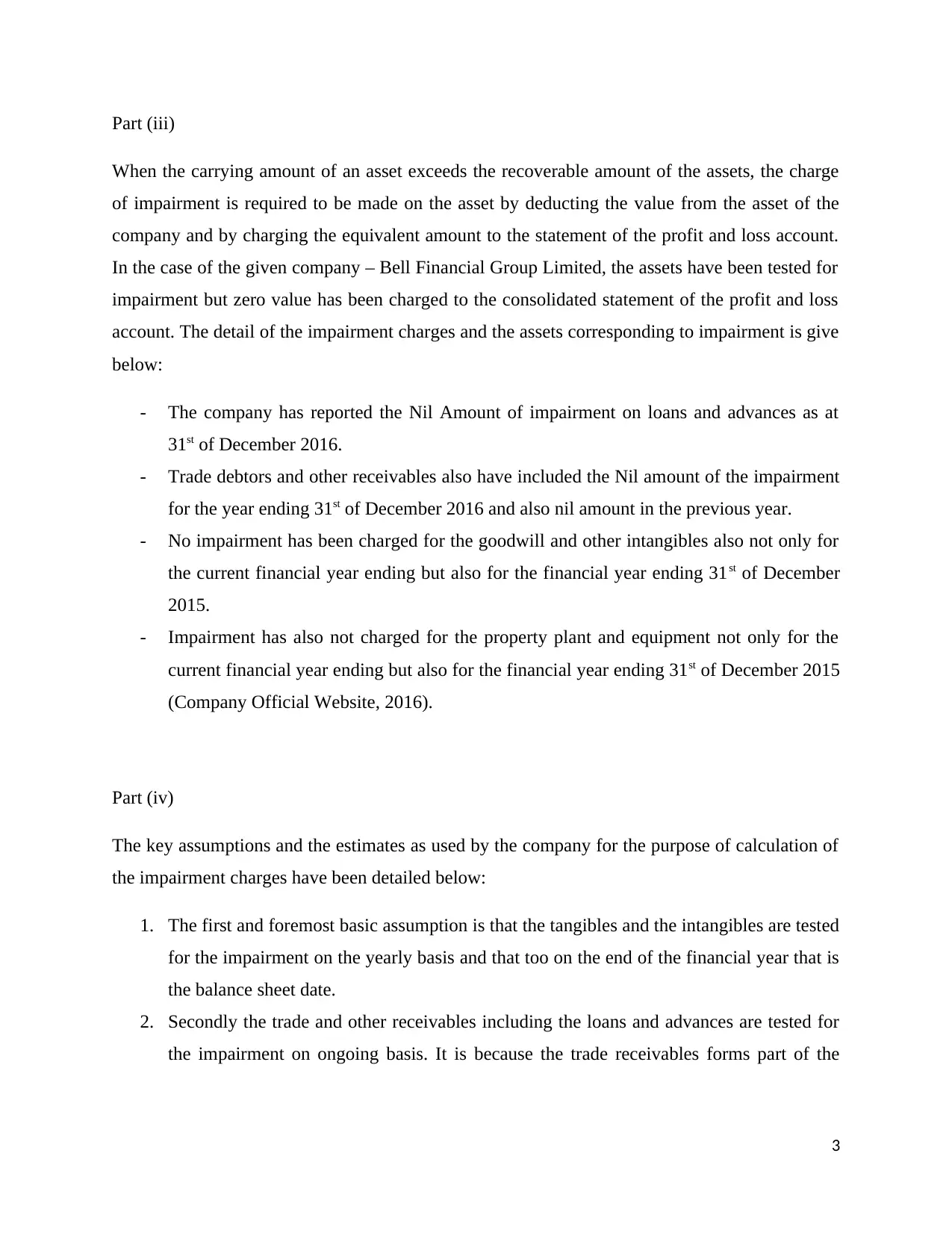
Part (iii)
When the carrying amount of an asset exceeds the recoverable amount of the assets, the charge
of impairment is required to be made on the asset by deducting the value from the asset of the
company and by charging the equivalent amount to the statement of the profit and loss account.
In the case of the given company – Bell Financial Group Limited, the assets have been tested for
impairment but zero value has been charged to the consolidated statement of the profit and loss
account. The detail of the impairment charges and the assets corresponding to impairment is give
below:
- The company has reported the Nil Amount of impairment on loans and advances as at
31st of December 2016.
- Trade debtors and other receivables also have included the Nil amount of the impairment
for the year ending 31st of December 2016 and also nil amount in the previous year.
- No impairment has been charged for the goodwill and other intangibles also not only for
the current financial year ending but also for the financial year ending 31st of December
2015.
- Impairment has also not charged for the property plant and equipment not only for the
current financial year ending but also for the financial year ending 31st of December 2015
(Company Official Website, 2016).
Part (iv)
The key assumptions and the estimates as used by the company for the purpose of calculation of
the impairment charges have been detailed below:
1. The first and foremost basic assumption is that the tangibles and the intangibles are tested
for the impairment on the yearly basis and that too on the end of the financial year that is
the balance sheet date.
2. Secondly the trade and other receivables including the loans and advances are tested for
the impairment on ongoing basis. It is because the trade receivables forms part of the
3
When the carrying amount of an asset exceeds the recoverable amount of the assets, the charge
of impairment is required to be made on the asset by deducting the value from the asset of the
company and by charging the equivalent amount to the statement of the profit and loss account.
In the case of the given company – Bell Financial Group Limited, the assets have been tested for
impairment but zero value has been charged to the consolidated statement of the profit and loss
account. The detail of the impairment charges and the assets corresponding to impairment is give
below:
- The company has reported the Nil Amount of impairment on loans and advances as at
31st of December 2016.
- Trade debtors and other receivables also have included the Nil amount of the impairment
for the year ending 31st of December 2016 and also nil amount in the previous year.
- No impairment has been charged for the goodwill and other intangibles also not only for
the current financial year ending but also for the financial year ending 31st of December
2015.
- Impairment has also not charged for the property plant and equipment not only for the
current financial year ending but also for the financial year ending 31st of December 2015
(Company Official Website, 2016).
Part (iv)
The key assumptions and the estimates as used by the company for the purpose of calculation of
the impairment charges have been detailed below:
1. The first and foremost basic assumption is that the tangibles and the intangibles are tested
for the impairment on the yearly basis and that too on the end of the financial year that is
the balance sheet date.
2. Secondly the trade and other receivables including the loans and advances are tested for
the impairment on ongoing basis. It is because the trade receivables forms part of the
3
⊘ This is a preview!⊘
Do you want full access?
Subscribe today to unlock all pages.

Trusted by 1+ million students worldwide
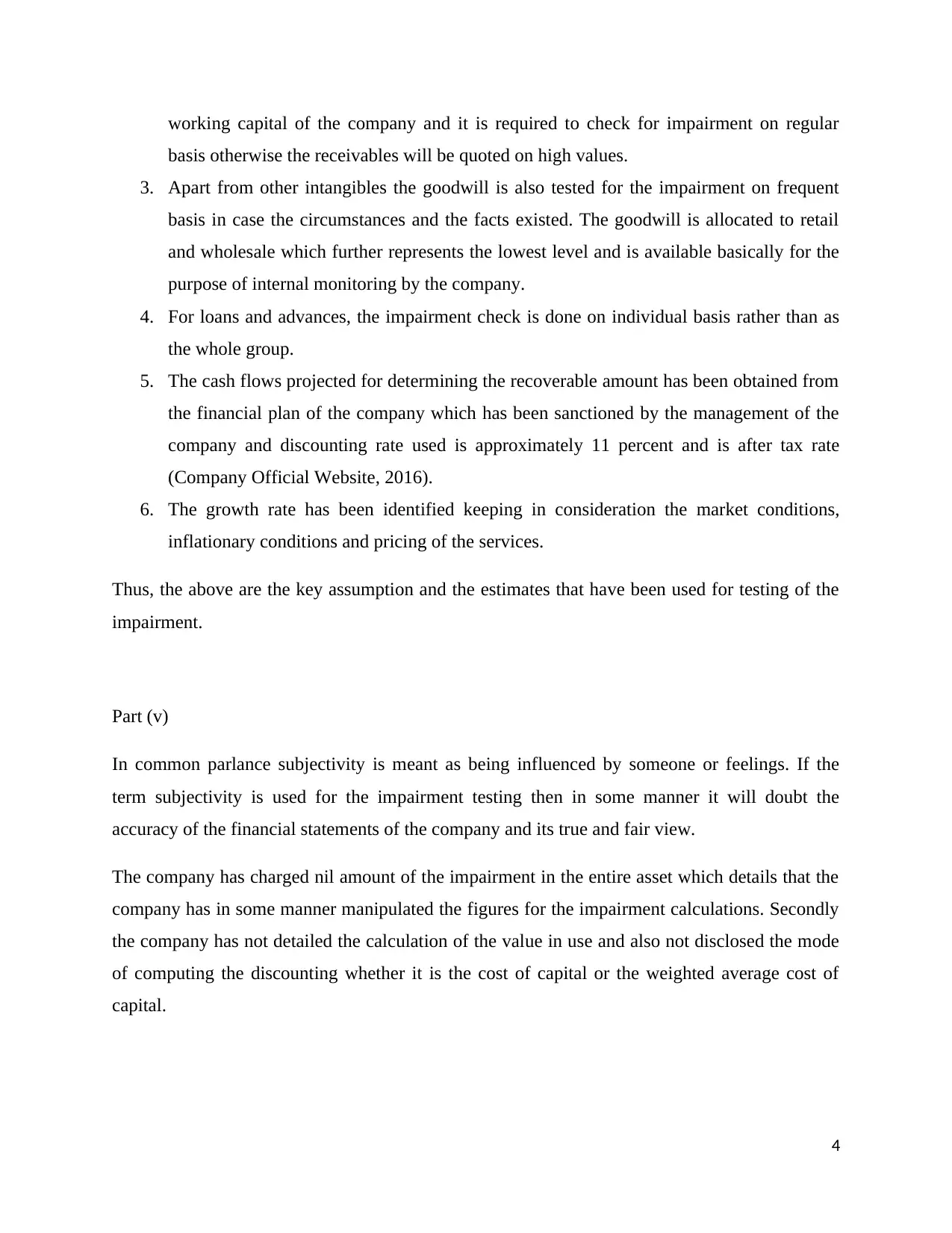
working capital of the company and it is required to check for impairment on regular
basis otherwise the receivables will be quoted on high values.
3. Apart from other intangibles the goodwill is also tested for the impairment on frequent
basis in case the circumstances and the facts existed. The goodwill is allocated to retail
and wholesale which further represents the lowest level and is available basically for the
purpose of internal monitoring by the company.
4. For loans and advances, the impairment check is done on individual basis rather than as
the whole group.
5. The cash flows projected for determining the recoverable amount has been obtained from
the financial plan of the company which has been sanctioned by the management of the
company and discounting rate used is approximately 11 percent and is after tax rate
(Company Official Website, 2016).
6. The growth rate has been identified keeping in consideration the market conditions,
inflationary conditions and pricing of the services.
Thus, the above are the key assumption and the estimates that have been used for testing of the
impairment.
Part (v)
In common parlance subjectivity is meant as being influenced by someone or feelings. If the
term subjectivity is used for the impairment testing then in some manner it will doubt the
accuracy of the financial statements of the company and its true and fair view.
The company has charged nil amount of the impairment in the entire asset which details that the
company has in some manner manipulated the figures for the impairment calculations. Secondly
the company has not detailed the calculation of the value in use and also not disclosed the mode
of computing the discounting whether it is the cost of capital or the weighted average cost of
capital.
4
basis otherwise the receivables will be quoted on high values.
3. Apart from other intangibles the goodwill is also tested for the impairment on frequent
basis in case the circumstances and the facts existed. The goodwill is allocated to retail
and wholesale which further represents the lowest level and is available basically for the
purpose of internal monitoring by the company.
4. For loans and advances, the impairment check is done on individual basis rather than as
the whole group.
5. The cash flows projected for determining the recoverable amount has been obtained from
the financial plan of the company which has been sanctioned by the management of the
company and discounting rate used is approximately 11 percent and is after tax rate
(Company Official Website, 2016).
6. The growth rate has been identified keeping in consideration the market conditions,
inflationary conditions and pricing of the services.
Thus, the above are the key assumption and the estimates that have been used for testing of the
impairment.
Part (v)
In common parlance subjectivity is meant as being influenced by someone or feelings. If the
term subjectivity is used for the impairment testing then in some manner it will doubt the
accuracy of the financial statements of the company and its true and fair view.
The company has charged nil amount of the impairment in the entire asset which details that the
company has in some manner manipulated the figures for the impairment calculations. Secondly
the company has not detailed the calculation of the value in use and also not disclosed the mode
of computing the discounting whether it is the cost of capital or the weighted average cost of
capital.
4
Paraphrase This Document
Need a fresh take? Get an instant paraphrase of this document with our AI Paraphraser
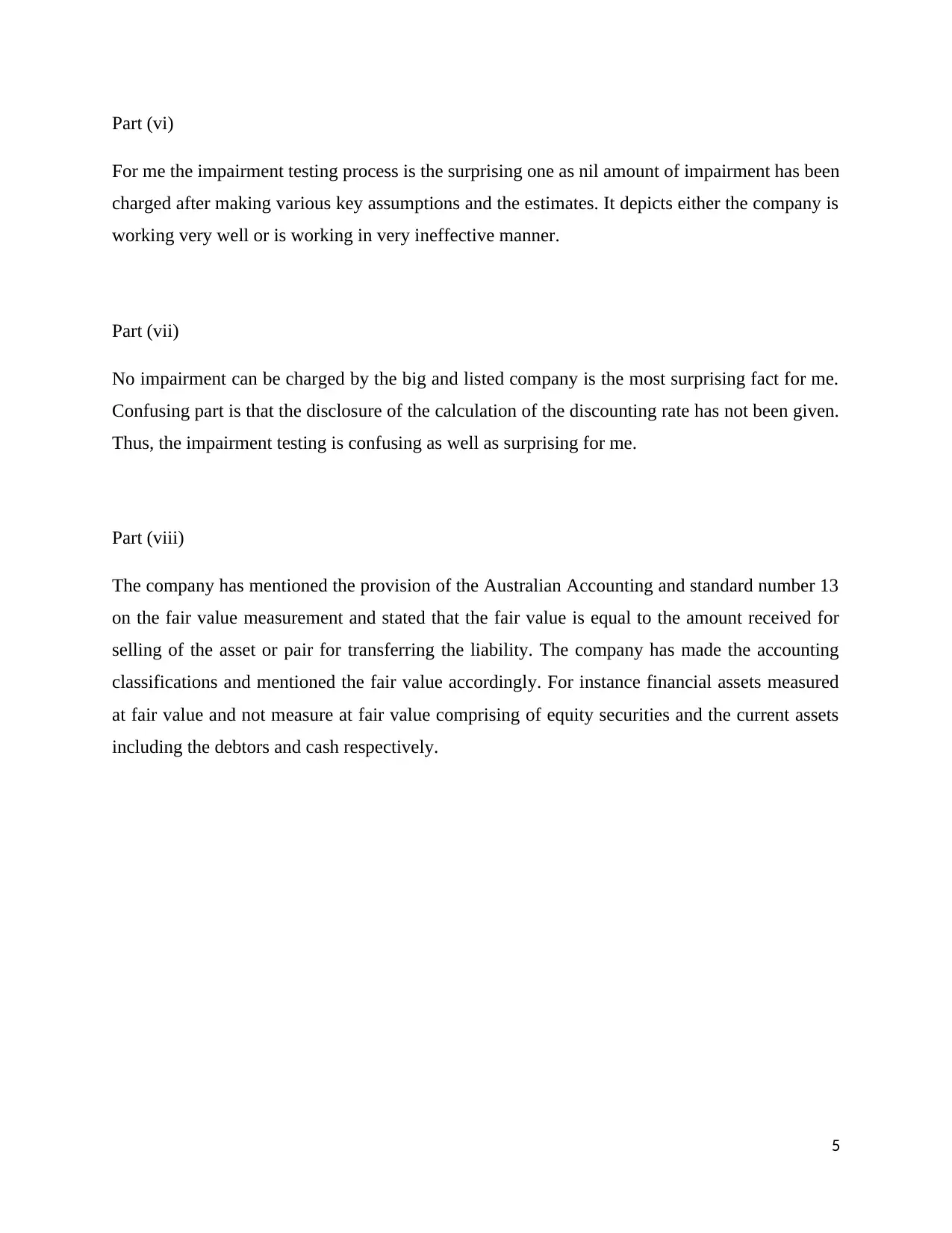
Part (vi)
For me the impairment testing process is the surprising one as nil amount of impairment has been
charged after making various key assumptions and the estimates. It depicts either the company is
working very well or is working in very ineffective manner.
Part (vii)
No impairment can be charged by the big and listed company is the most surprising fact for me.
Confusing part is that the disclosure of the calculation of the discounting rate has not been given.
Thus, the impairment testing is confusing as well as surprising for me.
Part (viii)
The company has mentioned the provision of the Australian Accounting and standard number 13
on the fair value measurement and stated that the fair value is equal to the amount received for
selling of the asset or pair for transferring the liability. The company has made the accounting
classifications and mentioned the fair value accordingly. For instance financial assets measured
at fair value and not measure at fair value comprising of equity securities and the current assets
including the debtors and cash respectively.
5
For me the impairment testing process is the surprising one as nil amount of impairment has been
charged after making various key assumptions and the estimates. It depicts either the company is
working very well or is working in very ineffective manner.
Part (vii)
No impairment can be charged by the big and listed company is the most surprising fact for me.
Confusing part is that the disclosure of the calculation of the discounting rate has not been given.
Thus, the impairment testing is confusing as well as surprising for me.
Part (viii)
The company has mentioned the provision of the Australian Accounting and standard number 13
on the fair value measurement and stated that the fair value is equal to the amount received for
selling of the asset or pair for transferring the liability. The company has made the accounting
classifications and mentioned the fair value accordingly. For instance financial assets measured
at fair value and not measure at fair value comprising of equity securities and the current assets
including the debtors and cash respectively.
5
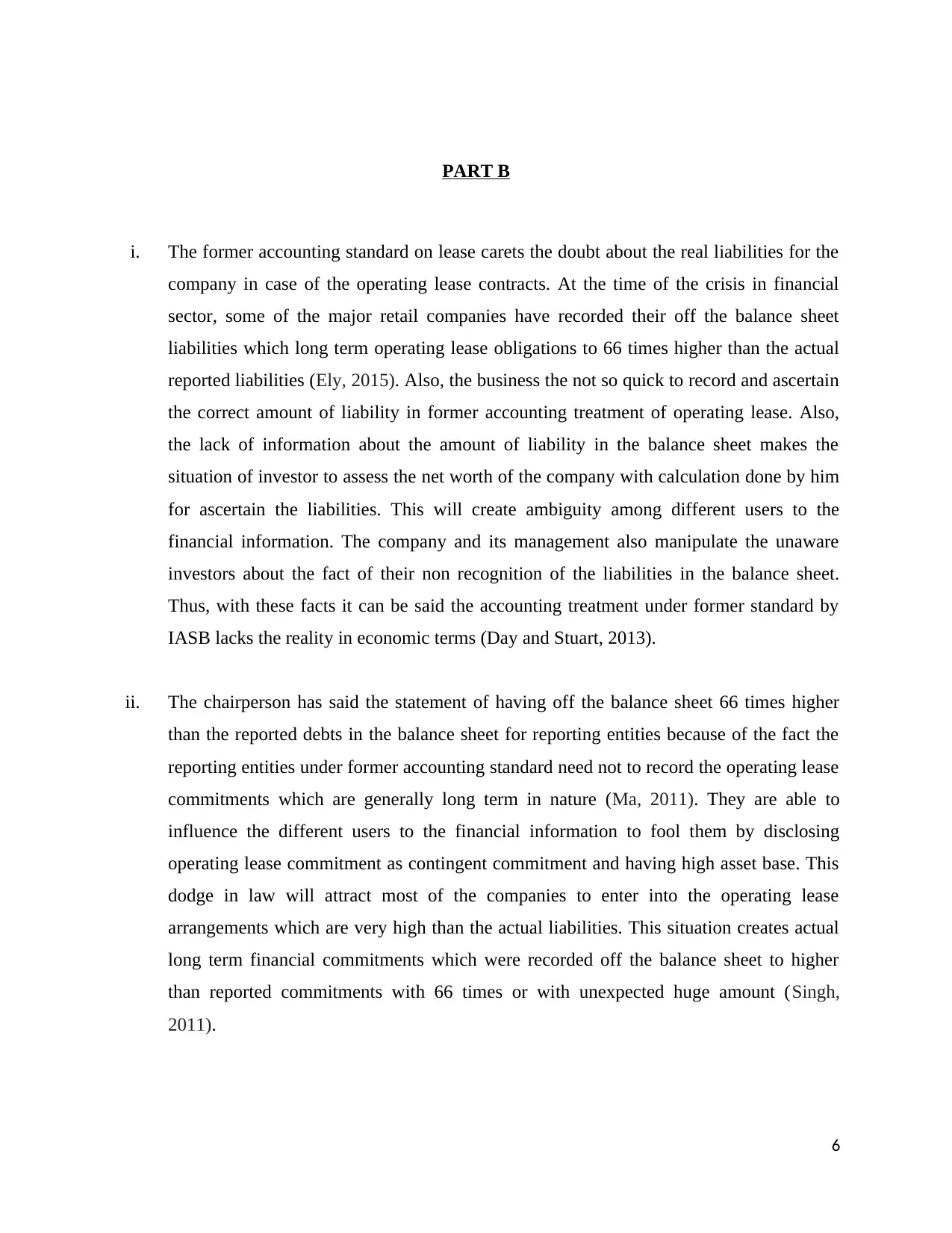
PART B
i. The former accounting standard on lease carets the doubt about the real liabilities for the
company in case of the operating lease contracts. At the time of the crisis in financial
sector, some of the major retail companies have recorded their off the balance sheet
liabilities which long term operating lease obligations to 66 times higher than the actual
reported liabilities (Ely, 2015). Also, the business the not so quick to record and ascertain
the correct amount of liability in former accounting treatment of operating lease. Also,
the lack of information about the amount of liability in the balance sheet makes the
situation of investor to assess the net worth of the company with calculation done by him
for ascertain the liabilities. This will create ambiguity among different users to the
financial information. The company and its management also manipulate the unaware
investors about the fact of their non recognition of the liabilities in the balance sheet.
Thus, with these facts it can be said the accounting treatment under former standard by
IASB lacks the reality in economic terms (Day and Stuart, 2013).
ii. The chairperson has said the statement of having off the balance sheet 66 times higher
than the reported debts in the balance sheet for reporting entities because of the fact the
reporting entities under former accounting standard need not to record the operating lease
commitments which are generally long term in nature (Ma, 2011). They are able to
influence the different users to the financial information to fool them by disclosing
operating lease commitment as contingent commitment and having high asset base. This
dodge in law will attract most of the companies to enter into the operating lease
arrangements which are very high than the actual liabilities. This situation creates actual
long term financial commitments which were recorded off the balance sheet to higher
than reported commitments with 66 times or with unexpected huge amount (Singh,
2011).
6
i. The former accounting standard on lease carets the doubt about the real liabilities for the
company in case of the operating lease contracts. At the time of the crisis in financial
sector, some of the major retail companies have recorded their off the balance sheet
liabilities which long term operating lease obligations to 66 times higher than the actual
reported liabilities (Ely, 2015). Also, the business the not so quick to record and ascertain
the correct amount of liability in former accounting treatment of operating lease. Also,
the lack of information about the amount of liability in the balance sheet makes the
situation of investor to assess the net worth of the company with calculation done by him
for ascertain the liabilities. This will create ambiguity among different users to the
financial information. The company and its management also manipulate the unaware
investors about the fact of their non recognition of the liabilities in the balance sheet.
Thus, with these facts it can be said the accounting treatment under former standard by
IASB lacks the reality in economic terms (Day and Stuart, 2013).
ii. The chairperson has said the statement of having off the balance sheet 66 times higher
than the reported debts in the balance sheet for reporting entities because of the fact the
reporting entities under former accounting standard need not to record the operating lease
commitments which are generally long term in nature (Ma, 2011). They are able to
influence the different users to the financial information to fool them by disclosing
operating lease commitment as contingent commitment and having high asset base. This
dodge in law will attract most of the companies to enter into the operating lease
arrangements which are very high than the actual liabilities. This situation creates actual
long term financial commitments which were recorded off the balance sheet to higher
than reported commitments with 66 times or with unexpected huge amount (Singh,
2011).
6
⊘ This is a preview!⊘
Do you want full access?
Subscribe today to unlock all pages.

Trusted by 1+ million students worldwide
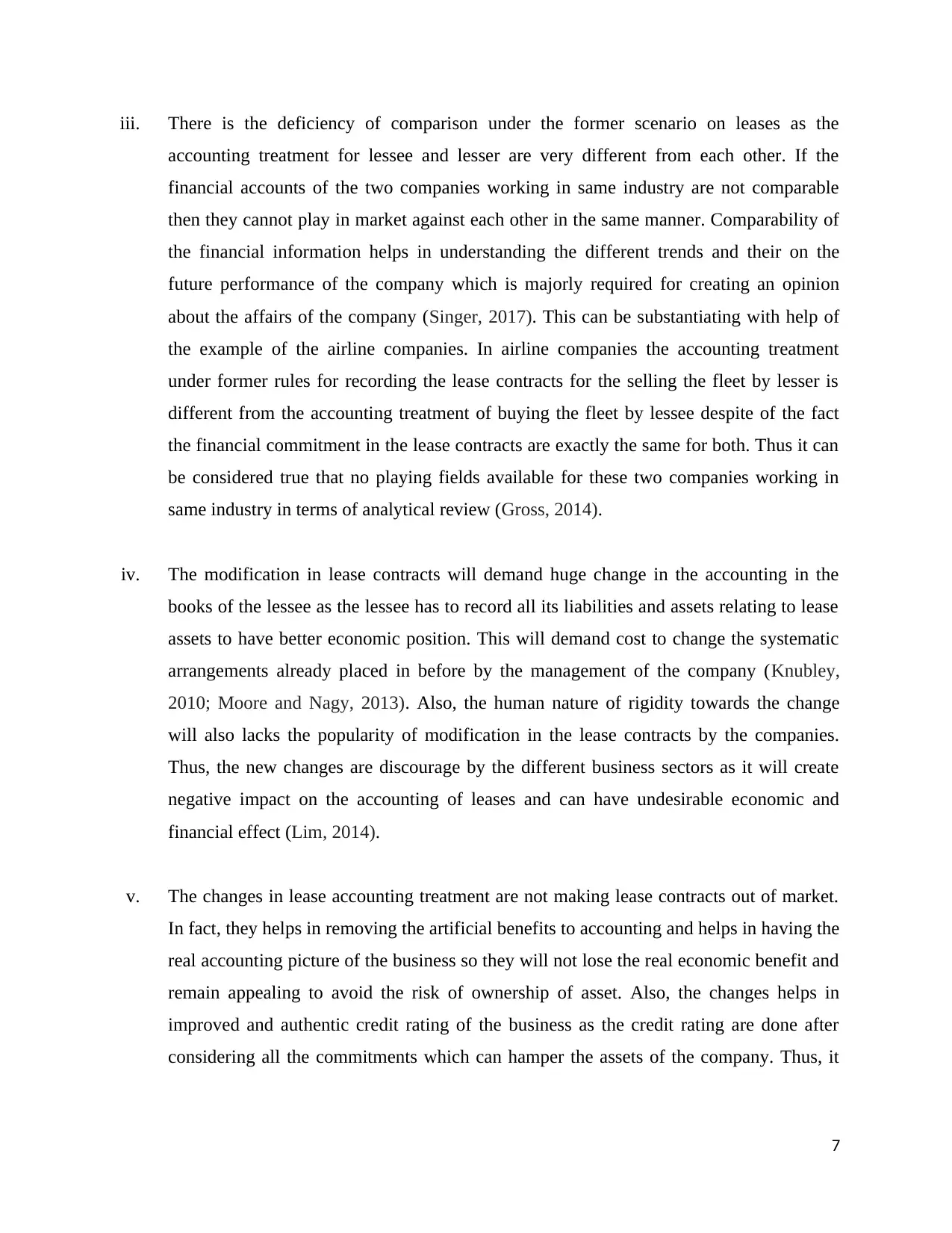
iii. There is the deficiency of comparison under the former scenario on leases as the
accounting treatment for lessee and lesser are very different from each other. If the
financial accounts of the two companies working in same industry are not comparable
then they cannot play in market against each other in the same manner. Comparability of
the financial information helps in understanding the different trends and their on the
future performance of the company which is majorly required for creating an opinion
about the affairs of the company (Singer, 2017). This can be substantiating with help of
the example of the airline companies. In airline companies the accounting treatment
under former rules for recording the lease contracts for the selling the fleet by lesser is
different from the accounting treatment of buying the fleet by lessee despite of the fact
the financial commitment in the lease contracts are exactly the same for both. Thus it can
be considered true that no playing fields available for these two companies working in
same industry in terms of analytical review (Gross, 2014).
iv. The modification in lease contracts will demand huge change in the accounting in the
books of the lessee as the lessee has to record all its liabilities and assets relating to lease
assets to have better economic position. This will demand cost to change the systematic
arrangements already placed in before by the management of the company (Knubley,
2010; Moore and Nagy, 2013). Also, the human nature of rigidity towards the change
will also lacks the popularity of modification in the lease contracts by the companies.
Thus, the new changes are discourage by the different business sectors as it will create
negative impact on the accounting of leases and can have undesirable economic and
financial effect (Lim, 2014).
v. The changes in lease accounting treatment are not making lease contracts out of market.
In fact, they helps in removing the artificial benefits to accounting and helps in having the
real accounting picture of the business so they will not lose the real economic benefit and
remain appealing to avoid the risk of ownership of asset. Also, the changes helps in
improved and authentic credit rating of the business as the credit rating are done after
considering all the commitments which can hamper the assets of the company. Thus, it
7
accounting treatment for lessee and lesser are very different from each other. If the
financial accounts of the two companies working in same industry are not comparable
then they cannot play in market against each other in the same manner. Comparability of
the financial information helps in understanding the different trends and their on the
future performance of the company which is majorly required for creating an opinion
about the affairs of the company (Singer, 2017). This can be substantiating with help of
the example of the airline companies. In airline companies the accounting treatment
under former rules for recording the lease contracts for the selling the fleet by lesser is
different from the accounting treatment of buying the fleet by lessee despite of the fact
the financial commitment in the lease contracts are exactly the same for both. Thus it can
be considered true that no playing fields available for these two companies working in
same industry in terms of analytical review (Gross, 2014).
iv. The modification in lease contracts will demand huge change in the accounting in the
books of the lessee as the lessee has to record all its liabilities and assets relating to lease
assets to have better economic position. This will demand cost to change the systematic
arrangements already placed in before by the management of the company (Knubley,
2010; Moore and Nagy, 2013). Also, the human nature of rigidity towards the change
will also lacks the popularity of modification in the lease contracts by the companies.
Thus, the new changes are discourage by the different business sectors as it will create
negative impact on the accounting of leases and can have undesirable economic and
financial effect (Lim, 2014).
v. The changes in lease accounting treatment are not making lease contracts out of market.
In fact, they helps in removing the artificial benefits to accounting and helps in having the
real accounting picture of the business so they will not lose the real economic benefit and
remain appealing to avoid the risk of ownership of asset. Also, the changes helps in
improved and authentic credit rating of the business as the credit rating are done after
considering all the commitments which can hamper the assets of the company. Thus, it
7
Paraphrase This Document
Need a fresh take? Get an instant paraphrase of this document with our AI Paraphraser
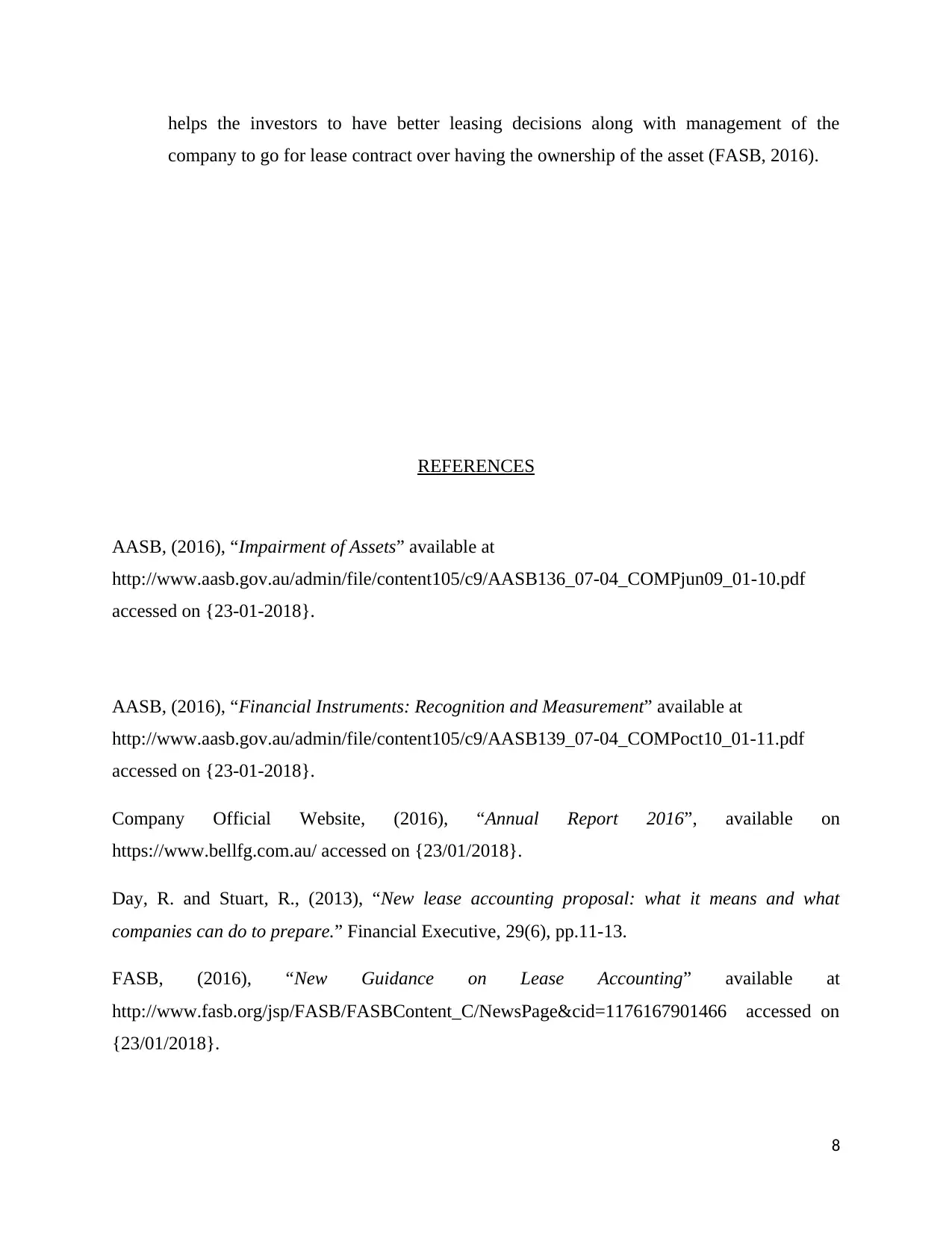
helps the investors to have better leasing decisions along with management of the
company to go for lease contract over having the ownership of the asset (FASB, 2016).
REFERENCES
AASB, (2016), “Impairment of Assets” available at
http://www.aasb.gov.au/admin/file/content105/c9/AASB136_07-04_COMPjun09_01-10.pdf
accessed on {23-01-2018}.
AASB, (2016), “Financial Instruments: Recognition and Measurement” available at
http://www.aasb.gov.au/admin/file/content105/c9/AASB139_07-04_COMPoct10_01-11.pdf
accessed on {23-01-2018}.
Company Official Website, (2016), “Annual Report 2016”, available on
https://www.bellfg.com.au/ accessed on {23/01/2018}.
Day, R. and Stuart, R., (2013), “New lease accounting proposal: what it means and what
companies can do to prepare.” Financial Executive, 29(6), pp.11-13.
FASB, (2016), “New Guidance on Lease Accounting” available at
http://www.fasb.org/jsp/FASB/FASBContent_C/NewsPage&cid=1176167901466 accessed on
{23/01/2018}.
8
company to go for lease contract over having the ownership of the asset (FASB, 2016).
REFERENCES
AASB, (2016), “Impairment of Assets” available at
http://www.aasb.gov.au/admin/file/content105/c9/AASB136_07-04_COMPjun09_01-10.pdf
accessed on {23-01-2018}.
AASB, (2016), “Financial Instruments: Recognition and Measurement” available at
http://www.aasb.gov.au/admin/file/content105/c9/AASB139_07-04_COMPoct10_01-11.pdf
accessed on {23-01-2018}.
Company Official Website, (2016), “Annual Report 2016”, available on
https://www.bellfg.com.au/ accessed on {23/01/2018}.
Day, R. and Stuart, R., (2013), “New lease accounting proposal: what it means and what
companies can do to prepare.” Financial Executive, 29(6), pp.11-13.
FASB, (2016), “New Guidance on Lease Accounting” available at
http://www.fasb.org/jsp/FASB/FASBContent_C/NewsPage&cid=1176167901466 accessed on
{23/01/2018}.
8
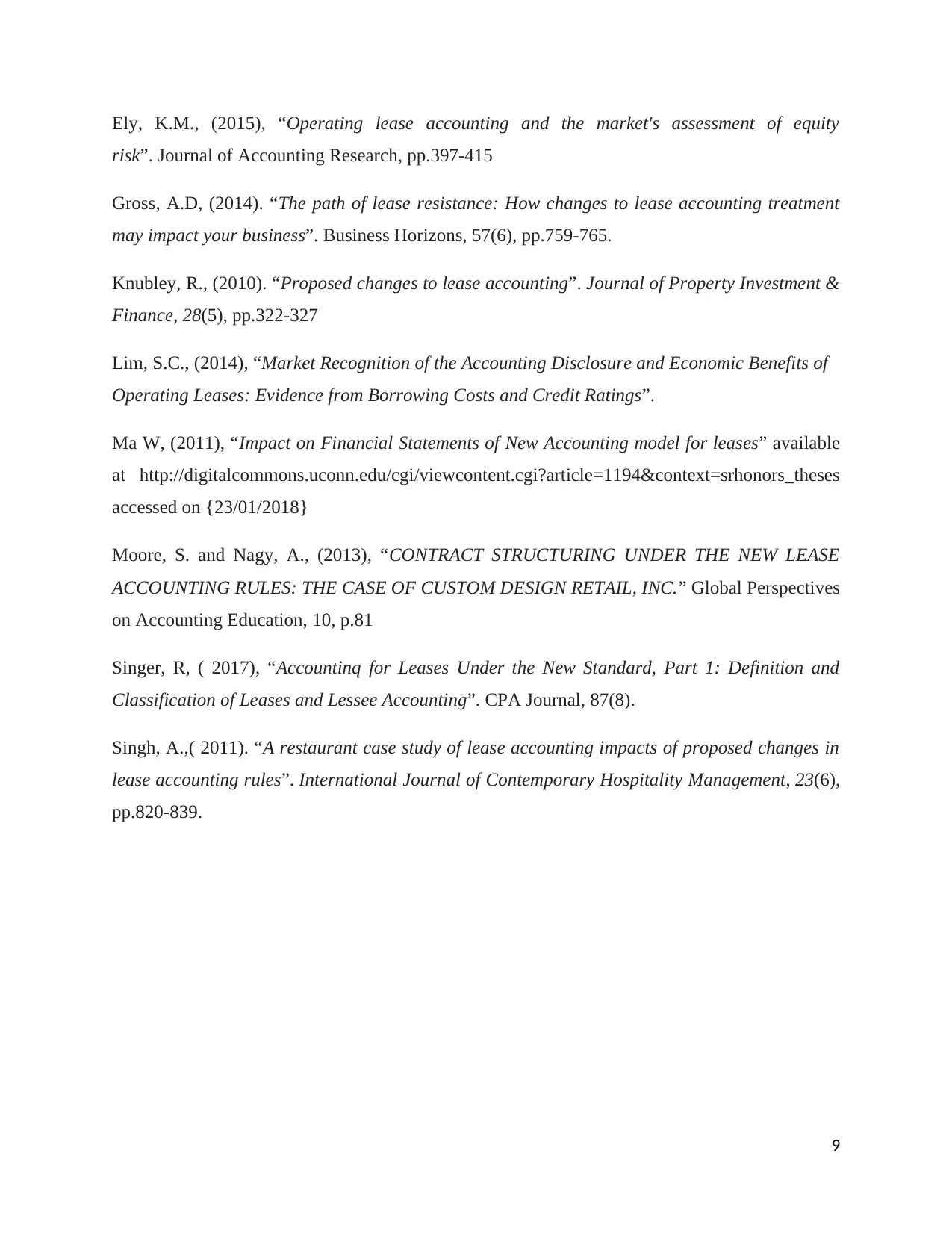
Ely, K.M., (2015), “Operating lease accounting and the market's assessment of equity
risk”. Journal of Accounting Research, pp.397-415
Gross, A.D, (2014). “The path of lease resistance: How changes to lease accounting treatment
may impact your business”. Business Horizons, 57(6), pp.759-765.
Knubley, R., (2010). “Proposed changes to lease accounting”. Journal of Property Investment &
Finance, 28(5), pp.322-327
Lim, S.C., (2014), “Market Recognition of the Accounting Disclosure and Economic Benefits of
Operating Leases: Evidence from Borrowing Costs and Credit Ratings”.
Ma W, (2011), “Impact on Financial Statements of New Accounting model for leases” available
at http://digitalcommons.uconn.edu/cgi/viewcontent.cgi?article=1194&context=srhonors_theses
accessed on {23/01/2018}
Moore, S. and Nagy, A., (2013), “CONTRACT STRUCTURING UNDER THE NEW LEASE
ACCOUNTING RULES: THE CASE OF CUSTOM DESIGN RETAIL, INC.” Global Perspectives
on Accounting Education, 10, p.81
Singer, R, ( 2017), “Accountinq for Leases Under the New Standard, Part 1: Definition and
Classification of Leases and Lessee Accounting”. CPA Journal, 87(8).
Singh, A.,( 2011). “A restaurant case study of lease accounting impacts of proposed changes in
lease accounting rules”. International Journal of Contemporary Hospitality Management, 23(6),
pp.820-839.
9
risk”. Journal of Accounting Research, pp.397-415
Gross, A.D, (2014). “The path of lease resistance: How changes to lease accounting treatment
may impact your business”. Business Horizons, 57(6), pp.759-765.
Knubley, R., (2010). “Proposed changes to lease accounting”. Journal of Property Investment &
Finance, 28(5), pp.322-327
Lim, S.C., (2014), “Market Recognition of the Accounting Disclosure and Economic Benefits of
Operating Leases: Evidence from Borrowing Costs and Credit Ratings”.
Ma W, (2011), “Impact on Financial Statements of New Accounting model for leases” available
at http://digitalcommons.uconn.edu/cgi/viewcontent.cgi?article=1194&context=srhonors_theses
accessed on {23/01/2018}
Moore, S. and Nagy, A., (2013), “CONTRACT STRUCTURING UNDER THE NEW LEASE
ACCOUNTING RULES: THE CASE OF CUSTOM DESIGN RETAIL, INC.” Global Perspectives
on Accounting Education, 10, p.81
Singer, R, ( 2017), “Accountinq for Leases Under the New Standard, Part 1: Definition and
Classification of Leases and Lessee Accounting”. CPA Journal, 87(8).
Singh, A.,( 2011). “A restaurant case study of lease accounting impacts of proposed changes in
lease accounting rules”. International Journal of Contemporary Hospitality Management, 23(6),
pp.820-839.
9
⊘ This is a preview!⊘
Do you want full access?
Subscribe today to unlock all pages.

Trusted by 1+ million students worldwide
1 out of 9
Related Documents
Your All-in-One AI-Powered Toolkit for Academic Success.
+13062052269
info@desklib.com
Available 24*7 on WhatsApp / Email
![[object Object]](/_next/static/media/star-bottom.7253800d.svg)
Unlock your academic potential
Copyright © 2020–2025 A2Z Services. All Rights Reserved. Developed and managed by ZUCOL.





